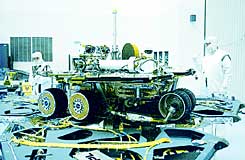The European Space Agency and NASA will launch unmanned research missions in June that will land on the surface of the "Red Planet"

In recent years, the planet Mars has received a lot of attention from scientists seeking to find signs of life there. The vast majority do not expect to find intelligent beings on the planet, but rather primitive life forms that managed to survive in the harsh conditions on its surface. Although no life has been discovered on the planet so far, many countries continue to send research missions to it.
On June 2, the European Space Agency will launch an unmanned research mission to the Red Planet. Three days later, NASA will also launch a similar mission. The research tools that will land on the planet will perform geological, biological and chemical tests. The main purpose of the mission is to locate signs of life.
At the beginning of the week, the space agencies of Russia and the United States agreed on cooperation in the study of the planet. At the end of talks in Moscow, the directors of the space agencies of the two countries, American Sean O'Keefe and his Russian counterpart Yuri Koptaev, announced that they had agreed to "cooperate in the exploration of Mars, and even launch joint unmanned missions to Mars."
The US, Russia and the European Union are investing billions of dollars in the Mars research programs, but these have been suffering from constant interruptions in recent months. The crash of the space shuttle "Columbia", for example, causes severe delays in NASA's plans. After the disaster, it was decided in the US to freeze all manned missions to space, and a large part of the unmanned missions were also postponed as a result. The delays call into question the promise of US President George Bush that by the end of the decade NASA will send a manned mission to Mars.
After the Columbia crash, Washington was asked to cooperate with the Russian space agency. However, since the dissolution of the Soviet Union, the Russian agency has been suffering from significant budget difficulties. NASA's financial strength and the Russian equipment - which is considered relatively reliable - allow the two former rivals to cooperate. For now, the cooperation is limited - similar to the "fight for the moon". Washington and Moscow are still competing to land the first man on Mars.
Mars is the fourth planet in the solar system. It orbits the sun for 687 days, and rotates on its axis once every 24 hours 37 minutes and 23 seconds. The atmosphere on Mars consists of 95% carbon dioxide, and the climate is mainly desert.
Satellite photographs, published in recent years, have shown signs that there are water sources on the surface of Mars. In a new study, published about two months ago in the USA, it is claimed that snow that fell on Mars millions of years ago caused the formation of the water reservoirs that flow over the surface of the planet. According to researchers, these findings may imply the existence of primitive life forms on the surface of Mars. This is also the main reason for the importance that scientists attach to the continuation of Mars research.
The possibility that life also originated outside the Earth is accepted today by most cosmologists. Astrophysicists estimate that millions of solar systems similar to ours have been formed throughout the universe, and therefore there is a high probability of life forming at least on some of the planets.
